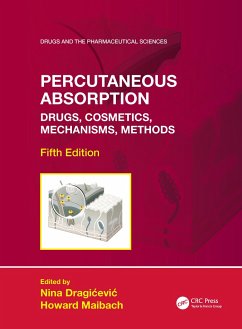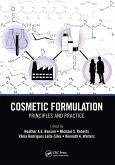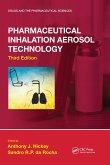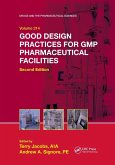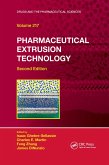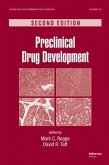Percutaneous Absorption
Drugs, Cosmetics, Mechanisms, Methods
Herausgeber: Dragicevic, Nina; Maibach, Howard
Percutaneous Absorption
Drugs, Cosmetics, Mechanisms, Methods
Herausgeber: Dragicevic, Nina; Maibach, Howard
- Gebundenes Buch
- Merkliste
- Auf die Merkliste
- Bewerten Bewerten
- Teilen
- Produkt teilen
- Produkterinnerung
- Produkterinnerung
Updating and expanding the scope of topics covered in the previous edition, Percutaneous Absorption supplies new studies on the role of the skin as a key portal of entry for chemicals into the body this book serves as a detailed reference source for recent advances in the field, as well as an experimental guide for laboratory personnel.
Andere Kunden interessierten sich auch für
![Percutaneous Absorption Percutaneous Absorption]() Percutaneous Absorption117,99 €
Percutaneous Absorption117,99 €![Cosmetic Formulation Cosmetic Formulation]() Cosmetic Formulation71,99 €
Cosmetic Formulation71,99 €![Cancer Targeting Therapies Cancer Targeting Therapies]() Cancer Targeting Therapies113,99 €
Cancer Targeting Therapies113,99 €![Pharmaceutical Inhalation Aerosol Technology, Third Edition Pharmaceutical Inhalation Aerosol Technology, Third Edition]() Pharmaceutical Inhalation Aerosol Technology, Third Edition51,99 €
Pharmaceutical Inhalation Aerosol Technology, Third Edition51,99 €![Good Design Practices for GMP Pharmaceutical Facilities Good Design Practices for GMP Pharmaceutical Facilities]() Good Design Practices for GMP Pharmaceutical Facilities52,99 €
Good Design Practices for GMP Pharmaceutical Facilities52,99 €![Pharmaceutical Extrusion Technology Pharmaceutical Extrusion Technology]() Pharmaceutical Extrusion Technology51,99 €
Pharmaceutical Extrusion Technology51,99 €![Preclinical Drug Development Preclinical Drug Development]() Preclinical Drug Development201,99 €
Preclinical Drug Development201,99 €-
-
-
Updating and expanding the scope of topics covered in the previous edition, Percutaneous Absorption supplies new studies on the role of the skin as a key portal of entry for chemicals into the body this book serves as a detailed reference source for recent advances in the field, as well as an experimental guide for laboratory personnel.
Hinweis: Dieser Artikel kann nur an eine deutsche Lieferadresse ausgeliefert werden.
Hinweis: Dieser Artikel kann nur an eine deutsche Lieferadresse ausgeliefert werden.
Produktdetails
- Produktdetails
- Drugs and the Pharmaceutical Sciences
- Verlag: Taylor & Francis Ltd
- 5 ed
- Seitenzahl: 990
- Erscheinungstermin: 30. Juli 2021
- Englisch
- Abmessung: 254mm x 178mm x 52mm
- Gewicht: 2048g
- ISBN-13: 9781138351233
- ISBN-10: 1138351237
- Artikelnr.: 62645666
- Herstellerkennzeichnung
- Libri GmbH
- Europaallee 1
- 36244 Bad Hersfeld
- gpsr@libri.de
- Drugs and the Pharmaceutical Sciences
- Verlag: Taylor & Francis Ltd
- 5 ed
- Seitenzahl: 990
- Erscheinungstermin: 30. Juli 2021
- Englisch
- Abmessung: 254mm x 178mm x 52mm
- Gewicht: 2048g
- ISBN-13: 9781138351233
- ISBN-10: 1138351237
- Artikelnr.: 62645666
- Herstellerkennzeichnung
- Libri GmbH
- Europaallee 1
- 36244 Bad Hersfeld
- gpsr@libri.de
Dr. Nina Dragi¿evi¿ is a professor in Pharmaceutical technology at the Department of Pharmacy at the Singidunum University in Belgrade, Serbia. She earned her master's degree at the University of Belgrade, Faculty of Pharmacy, in 1999 and subsequently earned a Magister Degree and a PhD ( summa cum laude, Dr. rer. nat.) in Pharmaceutical technology from the University of Belgrade and the Friedrich-Schiller University Jena, Germany, respectively. Before her employment at the University Singidunum, Dr. Dragi¿evi¿ worked as an accredited specialist in Pharmaceutical technology in the state pharmaceutical chain Apoteka "Beograd" in Belgrade. From 2007 to 2013 she was responsible for the preparation of compounded drugs for different routes of administration in pharmacies of Apoteka "Beograd", and in 2013 she was appointed director of the Production Department in the same company. She has published in a variety of international journals and she is editor of six books. Professor Howard I. Maibach, Ph.D. is currently serving as Professor of Dermatology at the University of California, San Francisco. He earned his MD from Tulane University, New Orleans, LA in 1955. Later he served in faculty positions in various levels at the UCSF. Dr. Maibach has over 2,520 published manuscripts. He has been on the editorial board of more than 30 scientific journals and is a member of 19 professional societies including the American Academy of Dermatology, San Francisco Dermatological Society and the Internal Commission on Occupation Health.
1 Molecular structure and function of the skin barrier 2 Mathematical
Models in Percutaneous Absorption 3 In Vivo Percutaneous Absorption: A Key
Role for Stratum Corneum/ Vehicle Partitioning 4 The Skin Reservoir for
Topically Applied Solutes 5 Chemical Partitioning into Powdered Human
Stratum Corneum: A Useful In Vitro Model for Studying Interaction of
Chemicals and Human Skin 6 Variations of Hair Follicle Size and
Distribution in Different Body Sites 7 In Vivo Relationship Between
Percutaneous Absorption and Transepidermal Water Loss 8 The correlation
between transepidermal water loss and percutaneous absorption: An updated
overview 9 Human Percutaneous Absorption and Transepidermal Water Loss
(TEWL) Correlation 10 Evaluation of Stratum Corneum Heterogeneity 11
Regional Variation in Percutaneous Absorption: Principles and Applications
to Human Risk Assessment 12 Effects of Anatomical Location on In Vivo
Percutaneous Penetration in Man 13 Interrelationships in the Dose-Response
of Percutaneous Absorption 14 Effects of Occlusion: Percutaneous Absorption
15 Occlusion Does Not Uniformly Enhance Penetration In Vivo 16 Effect of
Single vs. Multiple Dosing in Percutaneous Absorption 17 Influence of
formulation on topical and transdermal drug delivery 18 In Vitro Release
from Semisolid Dosage Forms-What Is Its Value? 19 Understanding Skin
Metabolism: Effect on Altering In Vitro Skin Absorption and Bioavailability
of Topically Applied Chemicals 20 Phenomenon of Lateral Spread in
Percutaneous Penetration 21 Clinically Pertinent Factors/Observations
Affecting Percutaneous Absorption in Humans 22 Percutaneous Absorption of
Chemical Mixtures 23 Dermal Decontamination and Percutaneous Absorption 24
Skin Decontaminartion 25 Chemical Warfare Agent VX Penetration Through
Military Uniform and Human Skin: Risk Assessment and Decontamination 26
Percutaneous Absorption of Hazardous Chemicals from Fabric into and Through
Human Skin 27 Percutaneous Absorption of Chemicals from Fabric (Textile) 28
The Fate of Material Remaining in Skin in In Vitro Absorption Studies 29
Skin Absorption of Hair Dyes 30 Hair Dye Penetration in Monkey and Man 31
Percutaneous Absorption of Sunscreens 32 Sunscreen Percutaneous Penetration
in Vivo in Man 33 Cutaneous Metabolism of Xenobiotics 34 Chemical
modification: an important and feasible method for improving peptide and
protein dermal and transdermal delivery 35 Enchancing Percutaneous
Penetration of Oligonucleotide Drugs 36 Use of Microemulsions for Topical
Drug Delivery 37 Transdermal Delivery of Vesicular Nanocarriers Under
Electrical Potential 38 Nanocarriers and physical methods 39 Assessment of
Microneedles for Transdermal Drug Delivery 40 Clinical Testing of
Microneedles for Transdermal Drug Delivery 41 Delivery of drugs, vaccines,
and cosmeceuticals to skin using microneedle patches 42 Mirconeedle
dermatotoxicology 43 Transdermal Transport by sonophoresis 44 Effect of
Tape Stripping on Percutaneous Penetration and Topical Vaccination 45
Transcutaneous Delivery of Drugs by Electroporation 46 IONTOPHORESIS IN
PENETRATION ENHANCEMENT 47 VEHICLES AND TOPICAL THERAPY 48 The role of in
vitro skin models in optimization of dermal drug delivery 49 Effects of
phospholipids on skin: use of primary human keratinocytes and fibroblasts
as 2D cell culture models 50 Human cadaver skin viability for in vitro
percutaneous absorption: storage and detrimental effects 51 Determination
of Percutaneous Absorption by In Vitro Techniques 52 Stripping Method for
Measuring Percutaneous Absorption In Vivo 53 Tape Stripping - Technique and
Applications 54 Blood flow as technology in percutaneous absorption 55
Confocal Raman Microspectroscopy in the assessment of skin barrier function
and drug penetration 56 Microscopy methods for assessing percutaneous drug
penetration 57 Dermal sampling techniques with focus on dermal Open Flow
Microperfusion 58 Dermal-epidermal Separation Methods: Research
Implications 59 Use of Skin Absorption Data in the Safety Evaluation of
Cosmetic Ingredients 60 Bioequivalence, Pharmaceutical Equivalence, and
Biowaivers: Topical Dosage Forms for Local Action 61 In Vitro Human Nail
Model To Evaluate Ungual Absorption and Transungual Delivery 62 Drug
Permeation through Burn Eschar: Possibilities and Improvements 63
Percutaneous Penetration in Humans: Transfer of Chemicals via Skin-to-Skin
Contact 64 Nanoparticles and Their Combination with Physical Methods for
Dermal and Transdermal Drug Delivery
Models in Percutaneous Absorption 3 In Vivo Percutaneous Absorption: A Key
Role for Stratum Corneum/ Vehicle Partitioning 4 The Skin Reservoir for
Topically Applied Solutes 5 Chemical Partitioning into Powdered Human
Stratum Corneum: A Useful In Vitro Model for Studying Interaction of
Chemicals and Human Skin 6 Variations of Hair Follicle Size and
Distribution in Different Body Sites 7 In Vivo Relationship Between
Percutaneous Absorption and Transepidermal Water Loss 8 The correlation
between transepidermal water loss and percutaneous absorption: An updated
overview 9 Human Percutaneous Absorption and Transepidermal Water Loss
(TEWL) Correlation 10 Evaluation of Stratum Corneum Heterogeneity 11
Regional Variation in Percutaneous Absorption: Principles and Applications
to Human Risk Assessment 12 Effects of Anatomical Location on In Vivo
Percutaneous Penetration in Man 13 Interrelationships in the Dose-Response
of Percutaneous Absorption 14 Effects of Occlusion: Percutaneous Absorption
15 Occlusion Does Not Uniformly Enhance Penetration In Vivo 16 Effect of
Single vs. Multiple Dosing in Percutaneous Absorption 17 Influence of
formulation on topical and transdermal drug delivery 18 In Vitro Release
from Semisolid Dosage Forms-What Is Its Value? 19 Understanding Skin
Metabolism: Effect on Altering In Vitro Skin Absorption and Bioavailability
of Topically Applied Chemicals 20 Phenomenon of Lateral Spread in
Percutaneous Penetration 21 Clinically Pertinent Factors/Observations
Affecting Percutaneous Absorption in Humans 22 Percutaneous Absorption of
Chemical Mixtures 23 Dermal Decontamination and Percutaneous Absorption 24
Skin Decontaminartion 25 Chemical Warfare Agent VX Penetration Through
Military Uniform and Human Skin: Risk Assessment and Decontamination 26
Percutaneous Absorption of Hazardous Chemicals from Fabric into and Through
Human Skin 27 Percutaneous Absorption of Chemicals from Fabric (Textile) 28
The Fate of Material Remaining in Skin in In Vitro Absorption Studies 29
Skin Absorption of Hair Dyes 30 Hair Dye Penetration in Monkey and Man 31
Percutaneous Absorption of Sunscreens 32 Sunscreen Percutaneous Penetration
in Vivo in Man 33 Cutaneous Metabolism of Xenobiotics 34 Chemical
modification: an important and feasible method for improving peptide and
protein dermal and transdermal delivery 35 Enchancing Percutaneous
Penetration of Oligonucleotide Drugs 36 Use of Microemulsions for Topical
Drug Delivery 37 Transdermal Delivery of Vesicular Nanocarriers Under
Electrical Potential 38 Nanocarriers and physical methods 39 Assessment of
Microneedles for Transdermal Drug Delivery 40 Clinical Testing of
Microneedles for Transdermal Drug Delivery 41 Delivery of drugs, vaccines,
and cosmeceuticals to skin using microneedle patches 42 Mirconeedle
dermatotoxicology 43 Transdermal Transport by sonophoresis 44 Effect of
Tape Stripping on Percutaneous Penetration and Topical Vaccination 45
Transcutaneous Delivery of Drugs by Electroporation 46 IONTOPHORESIS IN
PENETRATION ENHANCEMENT 47 VEHICLES AND TOPICAL THERAPY 48 The role of in
vitro skin models in optimization of dermal drug delivery 49 Effects of
phospholipids on skin: use of primary human keratinocytes and fibroblasts
as 2D cell culture models 50 Human cadaver skin viability for in vitro
percutaneous absorption: storage and detrimental effects 51 Determination
of Percutaneous Absorption by In Vitro Techniques 52 Stripping Method for
Measuring Percutaneous Absorption In Vivo 53 Tape Stripping - Technique and
Applications 54 Blood flow as technology in percutaneous absorption 55
Confocal Raman Microspectroscopy in the assessment of skin barrier function
and drug penetration 56 Microscopy methods for assessing percutaneous drug
penetration 57 Dermal sampling techniques with focus on dermal Open Flow
Microperfusion 58 Dermal-epidermal Separation Methods: Research
Implications 59 Use of Skin Absorption Data in the Safety Evaluation of
Cosmetic Ingredients 60 Bioequivalence, Pharmaceutical Equivalence, and
Biowaivers: Topical Dosage Forms for Local Action 61 In Vitro Human Nail
Model To Evaluate Ungual Absorption and Transungual Delivery 62 Drug
Permeation through Burn Eschar: Possibilities and Improvements 63
Percutaneous Penetration in Humans: Transfer of Chemicals via Skin-to-Skin
Contact 64 Nanoparticles and Their Combination with Physical Methods for
Dermal and Transdermal Drug Delivery
1 Molecular structure and function of the skin barrier 2 Mathematical
Models in Percutaneous Absorption 3 In Vivo Percutaneous Absorption: A Key
Role for Stratum Corneum/ Vehicle Partitioning 4 The Skin Reservoir for
Topically Applied Solutes 5 Chemical Partitioning into Powdered Human
Stratum Corneum: A Useful In Vitro Model for Studying Interaction of
Chemicals and Human Skin 6 Variations of Hair Follicle Size and
Distribution in Different Body Sites 7 In Vivo Relationship Between
Percutaneous Absorption and Transepidermal Water Loss 8 The correlation
between transepidermal water loss and percutaneous absorption: An updated
overview 9 Human Percutaneous Absorption and Transepidermal Water Loss
(TEWL) Correlation 10 Evaluation of Stratum Corneum Heterogeneity 11
Regional Variation in Percutaneous Absorption: Principles and Applications
to Human Risk Assessment 12 Effects of Anatomical Location on In Vivo
Percutaneous Penetration in Man 13 Interrelationships in the Dose-Response
of Percutaneous Absorption 14 Effects of Occlusion: Percutaneous Absorption
15 Occlusion Does Not Uniformly Enhance Penetration In Vivo 16 Effect of
Single vs. Multiple Dosing in Percutaneous Absorption 17 Influence of
formulation on topical and transdermal drug delivery 18 In Vitro Release
from Semisolid Dosage Forms-What Is Its Value? 19 Understanding Skin
Metabolism: Effect on Altering In Vitro Skin Absorption and Bioavailability
of Topically Applied Chemicals 20 Phenomenon of Lateral Spread in
Percutaneous Penetration 21 Clinically Pertinent Factors/Observations
Affecting Percutaneous Absorption in Humans 22 Percutaneous Absorption of
Chemical Mixtures 23 Dermal Decontamination and Percutaneous Absorption 24
Skin Decontaminartion 25 Chemical Warfare Agent VX Penetration Through
Military Uniform and Human Skin: Risk Assessment and Decontamination 26
Percutaneous Absorption of Hazardous Chemicals from Fabric into and Through
Human Skin 27 Percutaneous Absorption of Chemicals from Fabric (Textile) 28
The Fate of Material Remaining in Skin in In Vitro Absorption Studies 29
Skin Absorption of Hair Dyes 30 Hair Dye Penetration in Monkey and Man 31
Percutaneous Absorption of Sunscreens 32 Sunscreen Percutaneous Penetration
in Vivo in Man 33 Cutaneous Metabolism of Xenobiotics 34 Chemical
modification: an important and feasible method for improving peptide and
protein dermal and transdermal delivery 35 Enchancing Percutaneous
Penetration of Oligonucleotide Drugs 36 Use of Microemulsions for Topical
Drug Delivery 37 Transdermal Delivery of Vesicular Nanocarriers Under
Electrical Potential 38 Nanocarriers and physical methods 39 Assessment of
Microneedles for Transdermal Drug Delivery 40 Clinical Testing of
Microneedles for Transdermal Drug Delivery 41 Delivery of drugs, vaccines,
and cosmeceuticals to skin using microneedle patches 42 Mirconeedle
dermatotoxicology 43 Transdermal Transport by sonophoresis 44 Effect of
Tape Stripping on Percutaneous Penetration and Topical Vaccination 45
Transcutaneous Delivery of Drugs by Electroporation 46 IONTOPHORESIS IN
PENETRATION ENHANCEMENT 47 VEHICLES AND TOPICAL THERAPY 48 The role of in
vitro skin models in optimization of dermal drug delivery 49 Effects of
phospholipids on skin: use of primary human keratinocytes and fibroblasts
as 2D cell culture models 50 Human cadaver skin viability for in vitro
percutaneous absorption: storage and detrimental effects 51 Determination
of Percutaneous Absorption by In Vitro Techniques 52 Stripping Method for
Measuring Percutaneous Absorption In Vivo 53 Tape Stripping - Technique and
Applications 54 Blood flow as technology in percutaneous absorption 55
Confocal Raman Microspectroscopy in the assessment of skin barrier function
and drug penetration 56 Microscopy methods for assessing percutaneous drug
penetration 57 Dermal sampling techniques with focus on dermal Open Flow
Microperfusion 58 Dermal-epidermal Separation Methods: Research
Implications 59 Use of Skin Absorption Data in the Safety Evaluation of
Cosmetic Ingredients 60 Bioequivalence, Pharmaceutical Equivalence, and
Biowaivers: Topical Dosage Forms for Local Action 61 In Vitro Human Nail
Model To Evaluate Ungual Absorption and Transungual Delivery 62 Drug
Permeation through Burn Eschar: Possibilities and Improvements 63
Percutaneous Penetration in Humans: Transfer of Chemicals via Skin-to-Skin
Contact 64 Nanoparticles and Their Combination with Physical Methods for
Dermal and Transdermal Drug Delivery
Models in Percutaneous Absorption 3 In Vivo Percutaneous Absorption: A Key
Role for Stratum Corneum/ Vehicle Partitioning 4 The Skin Reservoir for
Topically Applied Solutes 5 Chemical Partitioning into Powdered Human
Stratum Corneum: A Useful In Vitro Model for Studying Interaction of
Chemicals and Human Skin 6 Variations of Hair Follicle Size and
Distribution in Different Body Sites 7 In Vivo Relationship Between
Percutaneous Absorption and Transepidermal Water Loss 8 The correlation
between transepidermal water loss and percutaneous absorption: An updated
overview 9 Human Percutaneous Absorption and Transepidermal Water Loss
(TEWL) Correlation 10 Evaluation of Stratum Corneum Heterogeneity 11
Regional Variation in Percutaneous Absorption: Principles and Applications
to Human Risk Assessment 12 Effects of Anatomical Location on In Vivo
Percutaneous Penetration in Man 13 Interrelationships in the Dose-Response
of Percutaneous Absorption 14 Effects of Occlusion: Percutaneous Absorption
15 Occlusion Does Not Uniformly Enhance Penetration In Vivo 16 Effect of
Single vs. Multiple Dosing in Percutaneous Absorption 17 Influence of
formulation on topical and transdermal drug delivery 18 In Vitro Release
from Semisolid Dosage Forms-What Is Its Value? 19 Understanding Skin
Metabolism: Effect on Altering In Vitro Skin Absorption and Bioavailability
of Topically Applied Chemicals 20 Phenomenon of Lateral Spread in
Percutaneous Penetration 21 Clinically Pertinent Factors/Observations
Affecting Percutaneous Absorption in Humans 22 Percutaneous Absorption of
Chemical Mixtures 23 Dermal Decontamination and Percutaneous Absorption 24
Skin Decontaminartion 25 Chemical Warfare Agent VX Penetration Through
Military Uniform and Human Skin: Risk Assessment and Decontamination 26
Percutaneous Absorption of Hazardous Chemicals from Fabric into and Through
Human Skin 27 Percutaneous Absorption of Chemicals from Fabric (Textile) 28
The Fate of Material Remaining in Skin in In Vitro Absorption Studies 29
Skin Absorption of Hair Dyes 30 Hair Dye Penetration in Monkey and Man 31
Percutaneous Absorption of Sunscreens 32 Sunscreen Percutaneous Penetration
in Vivo in Man 33 Cutaneous Metabolism of Xenobiotics 34 Chemical
modification: an important and feasible method for improving peptide and
protein dermal and transdermal delivery 35 Enchancing Percutaneous
Penetration of Oligonucleotide Drugs 36 Use of Microemulsions for Topical
Drug Delivery 37 Transdermal Delivery of Vesicular Nanocarriers Under
Electrical Potential 38 Nanocarriers and physical methods 39 Assessment of
Microneedles for Transdermal Drug Delivery 40 Clinical Testing of
Microneedles for Transdermal Drug Delivery 41 Delivery of drugs, vaccines,
and cosmeceuticals to skin using microneedle patches 42 Mirconeedle
dermatotoxicology 43 Transdermal Transport by sonophoresis 44 Effect of
Tape Stripping on Percutaneous Penetration and Topical Vaccination 45
Transcutaneous Delivery of Drugs by Electroporation 46 IONTOPHORESIS IN
PENETRATION ENHANCEMENT 47 VEHICLES AND TOPICAL THERAPY 48 The role of in
vitro skin models in optimization of dermal drug delivery 49 Effects of
phospholipids on skin: use of primary human keratinocytes and fibroblasts
as 2D cell culture models 50 Human cadaver skin viability for in vitro
percutaneous absorption: storage and detrimental effects 51 Determination
of Percutaneous Absorption by In Vitro Techniques 52 Stripping Method for
Measuring Percutaneous Absorption In Vivo 53 Tape Stripping - Technique and
Applications 54 Blood flow as technology in percutaneous absorption 55
Confocal Raman Microspectroscopy in the assessment of skin barrier function
and drug penetration 56 Microscopy methods for assessing percutaneous drug
penetration 57 Dermal sampling techniques with focus on dermal Open Flow
Microperfusion 58 Dermal-epidermal Separation Methods: Research
Implications 59 Use of Skin Absorption Data in the Safety Evaluation of
Cosmetic Ingredients 60 Bioequivalence, Pharmaceutical Equivalence, and
Biowaivers: Topical Dosage Forms for Local Action 61 In Vitro Human Nail
Model To Evaluate Ungual Absorption and Transungual Delivery 62 Drug
Permeation through Burn Eschar: Possibilities and Improvements 63
Percutaneous Penetration in Humans: Transfer of Chemicals via Skin-to-Skin
Contact 64 Nanoparticles and Their Combination with Physical Methods for
Dermal and Transdermal Drug Delivery

